Pulsed Polarization-Based NOx Sensors of YSZ Films Produced by the Aerosol Deposition Method and by Screen-Printing
Abstract
:1. Introduction
2. Experimental
2.1. Sensor Preparation
2.1.1. Aerosol Deposited Electrolytes
2.1.2. Screen-Printed Electrolytes
2.2. Measurements
3. Results and Discussion
3.1. Sensors with an Aerosol Deposited 8YSZ Electrolyte Film
3.2. Sensors with Screen-Printed and Sintered 8YSZ Electrolyte Films
4. Conclusions and Outlook
Acknowledgments
Authors Contribution
Conflicts of Interest
References
- Guth, U.; Zosel, J. Electrochemical solid electrolyte gas sensors—Hydrocarbon and NOx analysis in exhaust gases. Ionics 2004, 10, 366–377. [Google Scholar] [CrossRef]
- Miura, N.; Sato, T.; Anggraini, S.A.; Ikeda, H.; Zhuiykov, S. A review of mixed-potential type zirconia-based gas sensors. Ionics 2014, 20, 901–925. [Google Scholar] [CrossRef]
- Rapson, T.D.; Dacres, H. Analytical techniques for measuring nitrous oxide. TrAC Trends Anal. Chem. 2014, 54, 65–74. [Google Scholar] [CrossRef]
- Moos, R. A Brief Overview on Automotive Exhaust Gas Sensors Based on Electroceramics. Int. J. Appl. Ceram. Technol. 2005, 2, 401–413. [Google Scholar] [CrossRef]
- Akamatsu, T.; Itoh, T.; Izu, N.; Shin, W. NO and NO2 sensing properties of WO3 and Co3O4 based gas sensors. Sensors 2013, 13, 12467–12481. [Google Scholar] [CrossRef] [PubMed]
- Park, C.O.; Miura, N. Absolute potential analysis of the mixed potential occurring at the oxide/YSZ electrode at high temperature in NOx-containing air. Sens. Actuators B Chem. 2006, 113, 316–319. [Google Scholar] [CrossRef]
- Yin, C.; Guan, Y.; Zhu, Z.; Liang, X.; Wang, B.; Diao, Q.; Zhang, H.; Ma, J.; Liu, F.; Sun, Y.; et al. Highly sensitive mixed-potential-type NO2 sensor using porous double-layer YSZ substrate. Sens. Actuators B Chem. 2013, 183, 474–477. [Google Scholar] [CrossRef]
- Miura, N.; Wang, J.; Nakatou, M.; Elumalai, P.; Zhuiykov, S.; Hasei, M. High-temperature operating characteristics of mixed-potential-type NO2 sensor based on stabilized-zirconia tube and NiO sensing electrode. Sens. Actuators B Chem. 2006, 114, 903–909. [Google Scholar] [CrossRef]
- Figueroa, O.L.; Lee, C.; Akbar, S.A.; Szabo, N.F.; Trimboli, J.A.; Dutta, P.K.; Sawaki, N.; Soliman, A.A.; Verweij, H. Temperature-controlled CO, CO2 and NOx sensing in a diesel engine exhaust stream. Sens. Actuators B Chem. 2005, 107, 839–848. [Google Scholar] [CrossRef]
- Brosha, E.L.; Mukundan, R.; Brown, D.R.; Garzon, F.H.; Visser, J.H. Development of ceramic mixed potential sensors for automotive applications. Solid State Ionics 2002, 148, 61–69. [Google Scholar] [CrossRef]
- Guan, Y.; Li, C.; Cheng, X.; Wang, B.; Sun, R.; Liang, X.; Zhao, J.; Chen, H.; Lu, G. Highly sensitive mixed-potential-type NO2 sensor with YSZ processed using femtosecond laser direct writing technology. Sens. Actuators B Chem. 2014, 198, 110–113. [Google Scholar] [CrossRef]
- Cai, H.; Sun, R.; Yang, X.; Liang, X.; Wang, C.; Sun, P.; Liu, F.; Zhao, C.; Sun, Y.; Lu, G. Mixed-potential type NOx sensor using stabilized zirconia and MoO3-In2O3 nanocomposites. Ceram. Int. 2016, 42, 12503–12507. [Google Scholar] [CrossRef]
- Marr, I.; Moos, R. Resistive NOx dosimeter to detect very low NOx concentrations—Proof-of-principle and comparison with classical sensing devices. Sens. Actuators B Chem. 2017, 248, 848–855. [Google Scholar] [CrossRef]
- Groß, A.; Beulertz, G.; Marr, I.; Kubinski, D.J.; Visser, J.H.; Moos, R. Dual mode NOx sensor: Measuring both the accumulated amount and instantaneous level at low concentrations. Sensors 2012, 12, 2831–2850. [Google Scholar] [CrossRef] [PubMed]
- Fischer, S.; Pohle, R.; Farber, B.; Proch, R.; Kaniuk, J.; Fleischer, M.; Moos, R. Method for detection of NOx in exhaust gases by pulsed discharge measurements using standard zirconia-based lambda sensors. Sens. Actuators B Chem. 2010, 147, 780–785. [Google Scholar] [CrossRef]
- Fischer, S.; Schönauer-Kamin, D.; Pohle, R.; Fleischer, M.; Moos, R. NO Detection by Pulsed Polarization of Lambda Probes–Influence of the Reference Atmosphere. Sensors 2013, 13, 16051–16064. [Google Scholar] [CrossRef] [Green Version]
- Fischer, S.; Schönauer-Kamin, D.; Pohle, R.; Fleischer, M.; Moos, R. Influence of operation temperature variations on NO measurements in low concentrations when applying the pulsed polarization technique to thimble-type lambda probes. J. Sens. Sens. Syst. 2015, 4, 321–329. [Google Scholar] [CrossRef]
- Fischer, S.; Pohle, R.; Fleischer, M.; Moos, R. Method for reliable detection of different exhaust gas components by pulsed discharge measurements using standard zirconia based sensors. Procedia Chem. 2009, 1, 585–588. [Google Scholar] [CrossRef]
- Fischer, S.; Pohle, R.; Magori, E.; Fleischer, M.; Moos, R. Detection of NO by pulsed polarization of Pt I YSZ. Solid State Ionics 2014, 262, 288–291. [Google Scholar] [CrossRef]
- Fischer, S.; Pohle, R.; Magori, E.; Schönauer-Kamin, D.; Fleischer, M.; Moos, R. Pulsed polarization of platinum electrodes on YSZ. Solid State Ionics 2012, 225, 371–375. [Google Scholar] [CrossRef]
- Dietrich, M.; Hagen, G.; Reitmeier, W.; Burger, K.; Hien, M.; Grass, P.; Kubinski, D.; Visser, J.; Moos, R. Radio-Frequency-Based NH3-Selective Catalytic Reduction Catalyst Control: Studies on Temperature Dependency and Humidity Influences. Sensors 2017, 17, 1615. [Google Scholar] [CrossRef] [PubMed]
- Akedo, J. Room Temperature Impact Consolidation (RTIC) of Fine Ceramic Powder by Aerosol Deposition Method and Applications to Microdevices. J. Therm. Spray Technol. 2008, 17, 181–198. [Google Scholar] [CrossRef]
- Bektas, M.; Hanft, D.; Schönauer-Kamin, D.; Stöcker, T.; Hagen, G.; Moos, R. Aerosol-deposited BaFe0.7Ta0.3O3-δ for nitrogen monoxide and temperature-independent oxygen sensing. J. Sens. Sens. Syst. 2014, 3, 223–229. [Google Scholar] [CrossRef]
- Exner, J.; Schubert, M.; Hanft, D.; Stöcker, T.; Fuierer, P.; Moos, R. Tuning of the electrical conductivity of Sr(Ti,Fe)O3 oxygen sensing films by aerosol co-deposition with Al2O3. Sens. Actuators B Chem. 2016, 230, 427–433. [Google Scholar] [CrossRef]
- Hsiao, C.-C.; Liu, S.-Y. Multi-frequency band pyroelectric sensors. Sensors 2014, 14, 22180–22198. [Google Scholar] [CrossRef] [PubMed]
- Hsiao, C.-C.; Luo, L.-S. A Rapid Process for Fabricating Gas Sensors. Sensors 2014, 14, 12219–12232. [Google Scholar] [CrossRef] [PubMed]
- Kambale, R.C.; Patil, D.; Ryu, J.; Chai, Y.S.; Kim, K.H.; Yoon, W.-H.; Jeong, D.-Y.; Park, D.-S.; Kim, J.-W.; Choi, J.-J.; et al. Colossal magnetoelectric response of PZT thick films on Ni substrates with a conductive LaNiO3 electrode. J. Phys. D Appl. Phys. 2013, 46, 92002. [Google Scholar] [CrossRef]
- Ryu, J.; Han, G.; Lee, J.-P.; Lim, Y.-S.; Park, D.-S.; Jeong, D.-Y. Co and Fe Doping Effect on Negative Temperature Coefficient Characteristics of Nano-Grained NiMn2O4 Thick Films Fabricated by Aerosol-Deposition. J. Nanosci. Nanotechnol. 2013, 13, 3422–3426. [Google Scholar] [CrossRef] [PubMed]
- Ryu, J.; Kim, K.-Y.; Choi, J.-J.; Hahn, B.-D.; Yoon, W.-H.; Lee, B.-K.; Park, D.-S.; Park, C. Highly Dense and Nanograined NiMn2O4 Negative Temperature coefficient Thermistor Thick Films Fabricated by Aerosol-Deposition. J. Am. Ceram. Soc. 2009, 92, 3084–3087. [Google Scholar] [CrossRef]
- Sahner, K.; Kaspar, M.; Moos, R. Assessment of the novel aerosol deposition method for room temperature preparation of metal oxide gas sensor films. Sens. Actuators B Chem. 2009, 139, 394–399. [Google Scholar] [CrossRef]
- Hanft, D.; Exner, J.; Schubert, M.; Stöcker, T.; Fuierer, P.; Moos, R. An Overview of the Aerosol Deposition Method: Process Fundamentals and New Trends in Materials Applications. J. Ceram. Sci. Technol. 2015, 6, 147–182. [Google Scholar] [CrossRef]
- Casselton, R.E.W. Blackening in yttria stabilized zirconia due to cathodic processes at solid platinum electrodes. J. Appl. Electrochem. 1974, 4, 25–48. [Google Scholar] [CrossRef]
- Janek, J. Electrochemical blackening of yttria-stabilized zirconia—Morphological instability of the moving reaction front. Solid State Ionics 1999, 116, 181–195. [Google Scholar] [CrossRef]
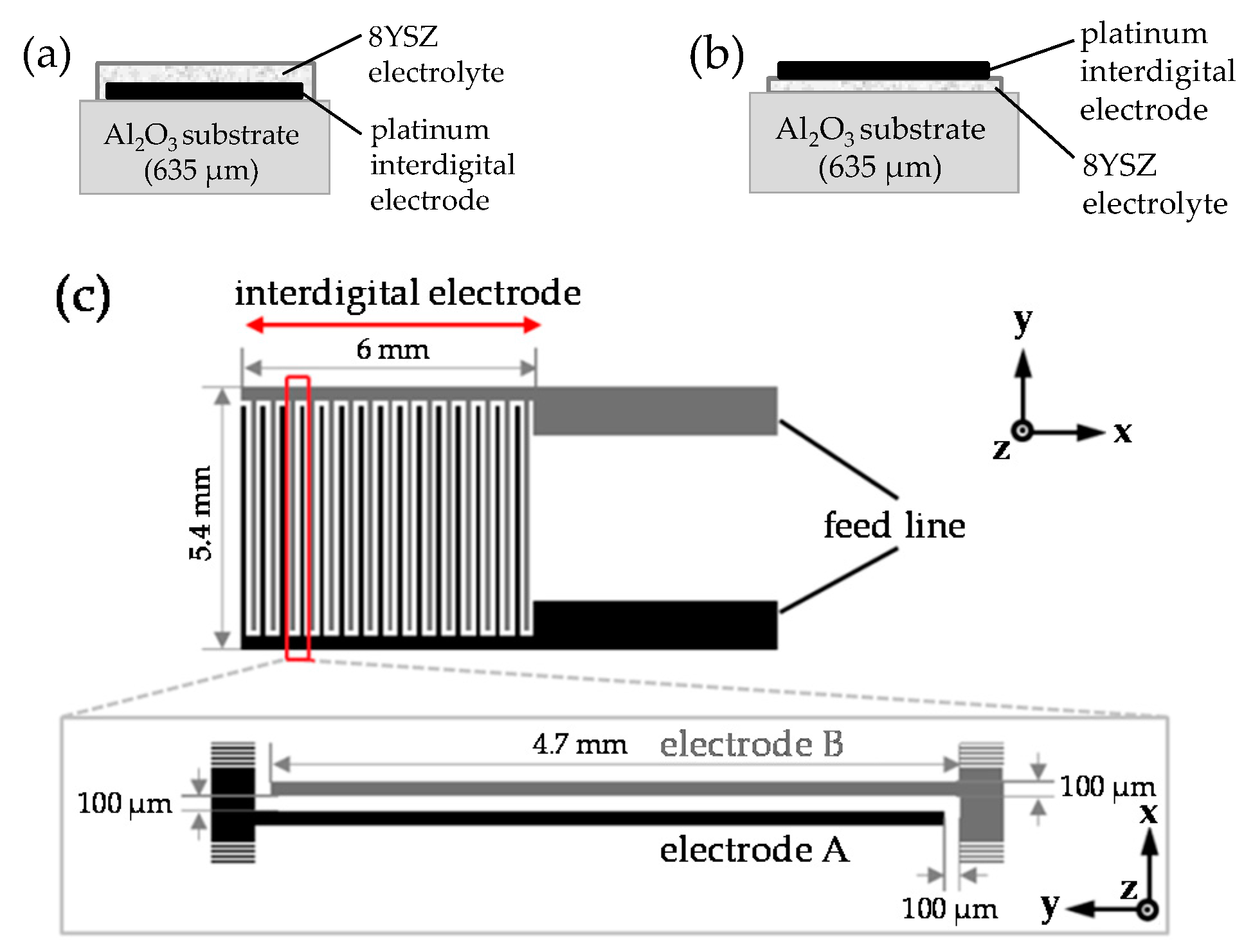


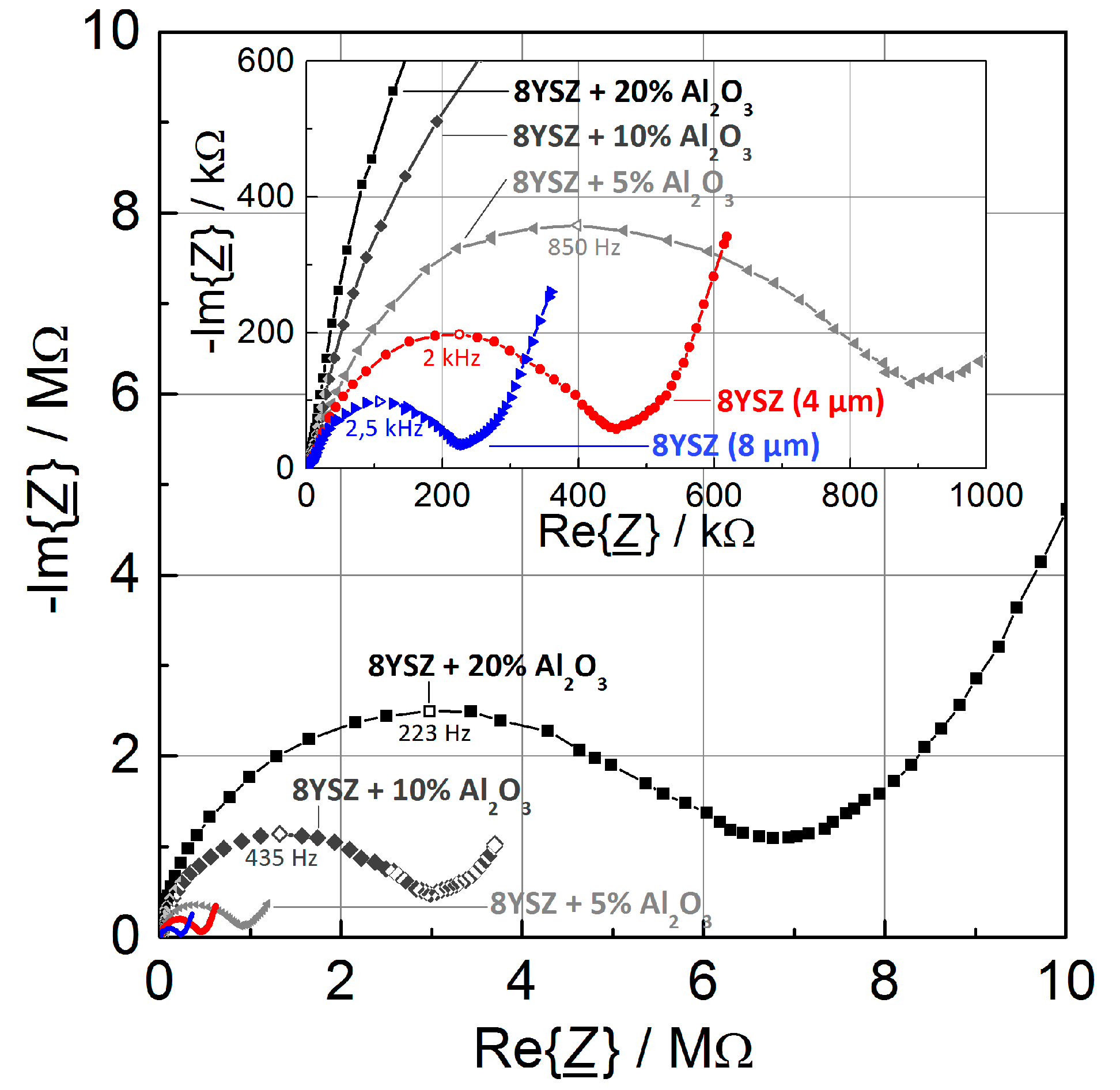


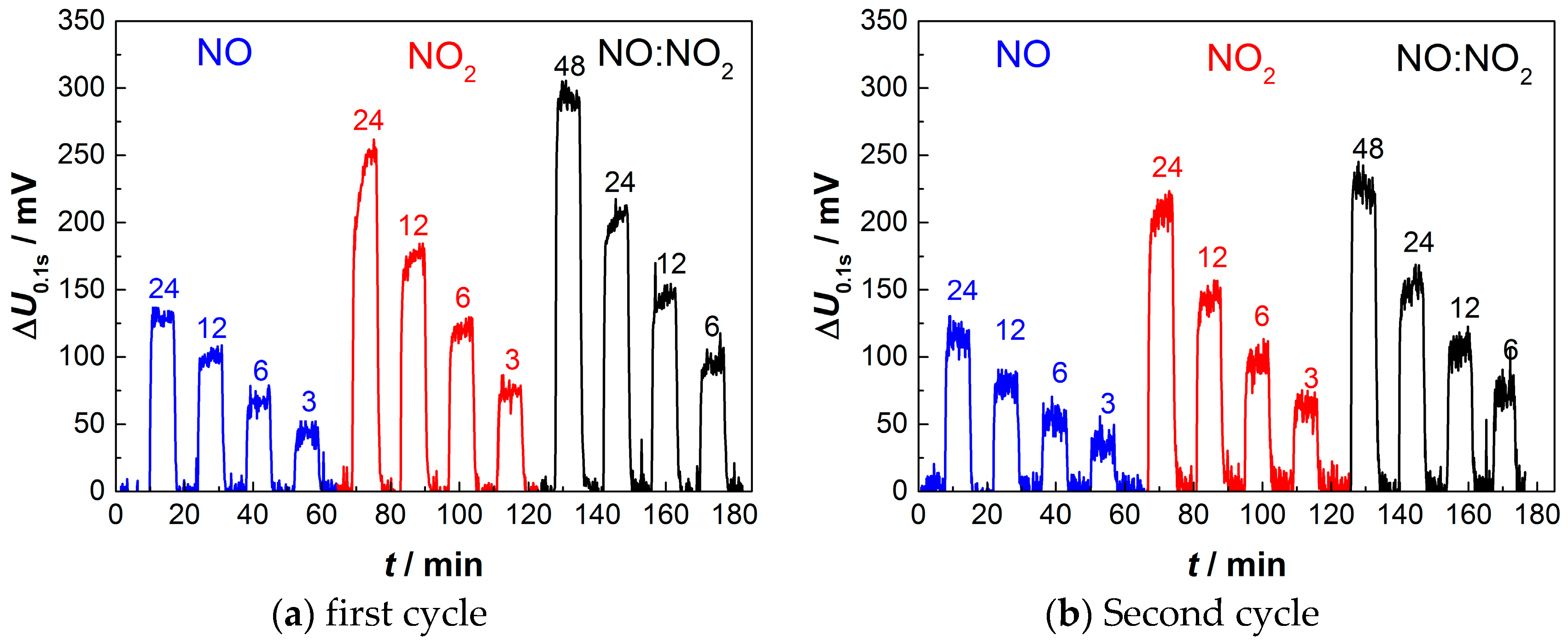

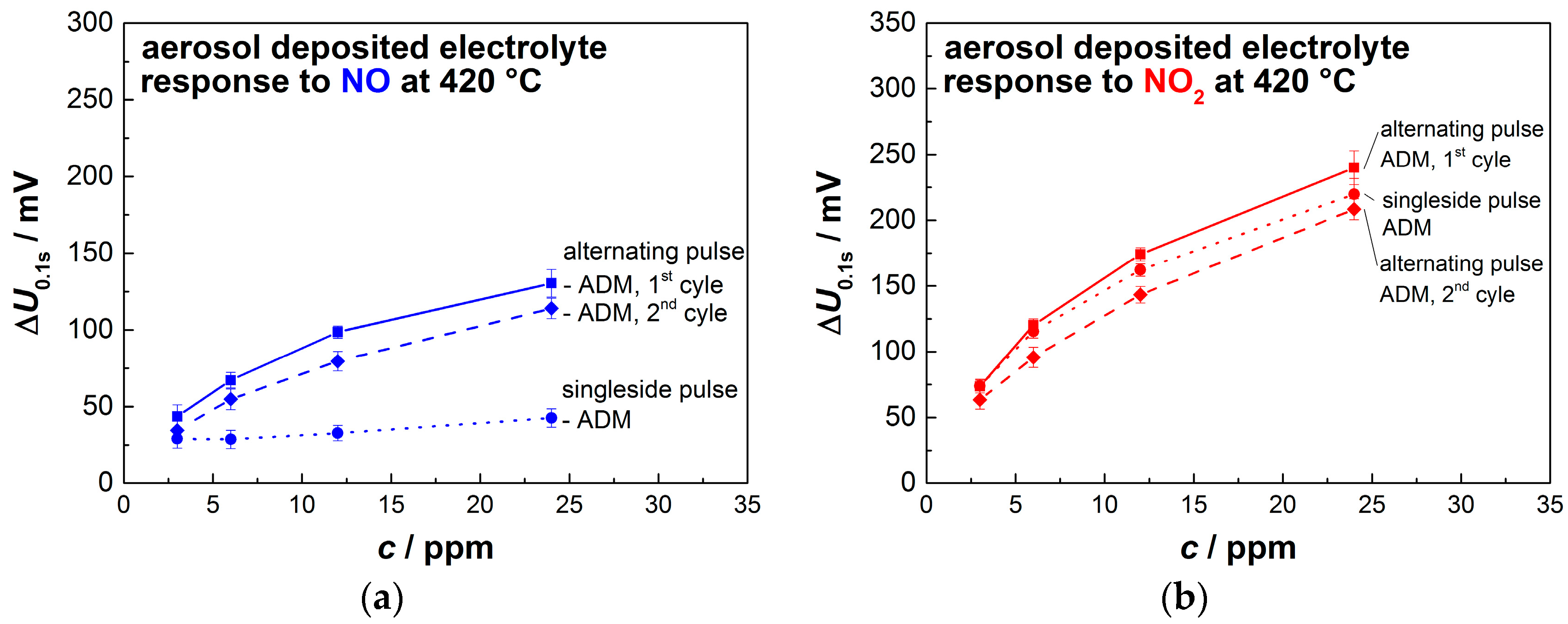

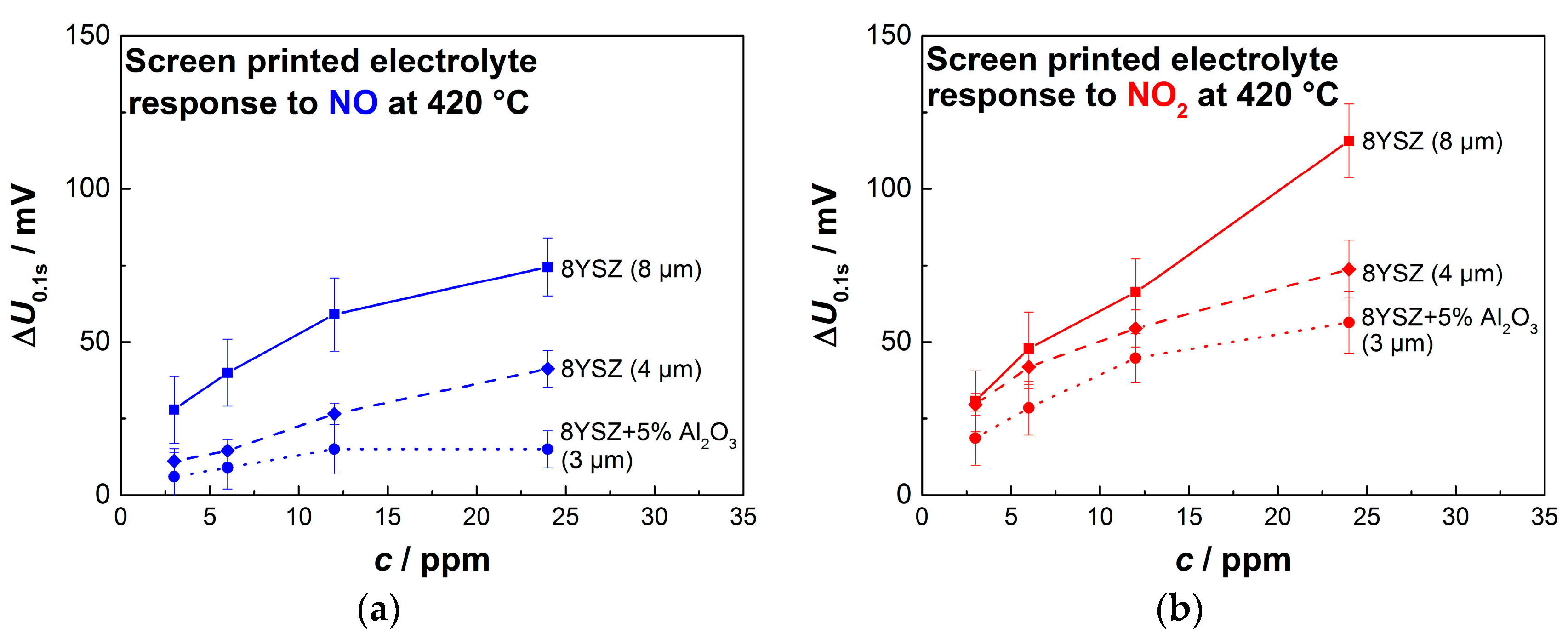
| # | Composition | 8YSZ Thickness | Position of Pt Electrode |
|---|---|---|---|
| AD 1 | 8YSZ | 5 µm | overlying |
| AD 2 | 8YSZ | 6 µm | buried |
| SP 1 | 8YSZ | 8–9 µm 1 | overlying |
| SP 2 | 8YSZ | 4 µm | overlying |
| SP 3 | 8YSZ + 5% Al2O3 | 3 µm | overlying |
| SP 4 | 8YSZ + 10% Al2O3 | 3 µm | overlying |
| SP 5 | 8YSZ + 20% Al2O3 | 4 µm | overlying |
| SP 6 | 8YSZ | 9 µm | buried |
| SP 7 | 8YSZ + 5% Al2O3 | 7 µm | buried |
| SP 8 | 8YSZ + 20% Al2O3 | 8 µm | buried |
© 2017 by the authors. Licensee MDPI, Basel, Switzerland. This article is an open access article distributed under the terms and conditions of the Creative Commons Attribution (CC BY) license (http://creativecommons.org/licenses/by/4.0/).
Share and Cite
Exner, J.; Albrecht, G.; Schönauer-Kamin, D.; Kita, J.; Moos, R. Pulsed Polarization-Based NOx Sensors of YSZ Films Produced by the Aerosol Deposition Method and by Screen-Printing. Sensors 2017, 17, 1715. https://doi.org/10.3390/s17081715
Exner J, Albrecht G, Schönauer-Kamin D, Kita J, Moos R. Pulsed Polarization-Based NOx Sensors of YSZ Films Produced by the Aerosol Deposition Method and by Screen-Printing. Sensors. 2017; 17(8):1715. https://doi.org/10.3390/s17081715
Chicago/Turabian StyleExner, Jörg, Gaby Albrecht, Daniela Schönauer-Kamin, Jaroslaw Kita, and Ralf Moos. 2017. "Pulsed Polarization-Based NOx Sensors of YSZ Films Produced by the Aerosol Deposition Method and by Screen-Printing" Sensors 17, no. 8: 1715. https://doi.org/10.3390/s17081715






